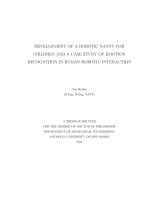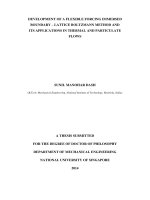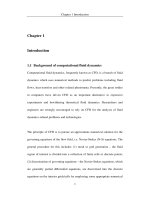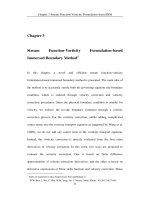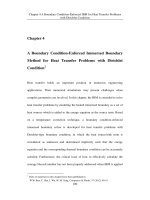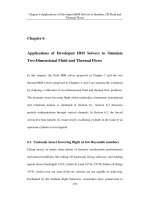Development of a flexible forcing immersed boundary lattice boltzmann method and its applications in thermal and particulate flows
Bạn đang xem bản rút gọn của tài liệu. Xem và tải ngay bản đầy đủ của tài liệu tại đây (7.76 MB, 266 trang )
DEVELOPMENT OF A FLEXIBLE FORCING IMMERSED
BOUNDARY – LATTICE BOLTZMANN METHOD AND
ITS APPLICATIONS IN THERMAL AND PARTICULATE
FLOWS
SUNIL MANOHAR DASH
(B.Tech. Mechanical Engineering, National Institute of Technology, Rourkela, India)
A THESIS SUBMITTED
FOR THE DEGREE OF DOCTOR OF PHILOSOPHY
DEPARTMENT OF MECHANICAL ENGINEERING
NATIONAL UNIVERSITY OF SINGAPORE
2014
i
Declaration
I hereby declare that this thesis is my original work and it has been written by
me entirely. I have duly acknowledged all the sources of information which
has been used in the thesis.
This thesis has also not been submitted for any degree in any university
previously.
_______________________________
Sunil Manohar Dash
ii
Acknowledgements
First of all, I would like to express my sincere gratitude to my supervisor,
Associate Professor Thong See Lee and my advisor, Associate Professor
Huang Haibo (USTC, China) for their invaluable guidance, supervision,
encouragement and support on my research and thesis work.
I am deeply grateful to my beloved late father for his confidence and love on
me. I wish you are here to share this success with us. I am thankful to my
mother and younger brother for being with me during these tough times and
for their continuous encouragement and love.
In addition, I am sincerely thankful to Professor Tee Tai Lim for guiding me
through the experimental studies and continuous motivation in these years. I
am also thankful to Professor Shu Chang for his valuable clarifications on
LBM concepts.
It won’t be complete without acknowledging my colleagues, Dr. Jiangyan
Shao, Dr. Wang Liping, Mrs. Tanuja, Mr. Thirukumaran, Mr. Pardha, Mr.
Ashoke, Mr. Vivek and many others for their direct and indirect supports which
pushed me through this phase of journey.
Finally, I am grateful to the National University of Singapore for granting the
research scholarship and precious opportunity to pursue the Doctor of
Philosophy degree.
Sunil Manohar Dash
iii
Table of Contents
Declaration i
Acknowledgements ii
Table of Contents iii
Summary vii
List of Tables x
List of Figures xii
Nomenclatures xviii
1 Chapter 1 1
Introduction and Literature Review 1
1.1 Background 1
1.2 Immersed boundary method 5
1.2.1 Defects in immersed boundary method 8
1.3 Lattice Boltzmann method 10
1.4 Thermal lattice Boltzmann method 13
1.5 Coupled immersed boundary – lattice Boltzmann method 15
1.6 Applications in thermal and moving boundary problems using
immersed boundary – lattice Boltzmann method 17
1.6.1 Natural convection in a complex cavity 17
1.6.2 Particle sedimentation 20
1.7 Objective of the thesis 24
1.8 Outline of the thesis 26
2 Chapter 2 28
A 2D Flexible Forcing Immersed Boundary and Lattice Boltzmann Method. 28
iv
2.1 Numerical methodology 29
2.1.1 Lattice Boltzmann method 29
2.1.2 Immersed Boundary method 34
2.1.3 Flexible forcing immersed boundary – lattice Boltzmann method
36
2.1.4 Kinematics of particulate flow 45
2.2 Accuracy test and Validations 48
2.2.1 Taylor – Green decaying vortex 48
2.2.2 Lid – driven cavity 51
2.2.3 Laminar flow past circular cylinder 54
2.2.4 A motion of the neutral buoyant particle in the linear shear flow
58
2.2.5 Single particle sedimentation 61
2.2.6 Two particles sedimentation 65
2.3 Concluding remarks 67
3 Chapter 3 69
Application of 2D Flexible Forcing IB –LBM for Particulate Flow in a
Constricted Channel 69
3.1 Problem definition 70
3.2 Results and Discussion 73
3.2.1 Single particle sedimentation 73
3.2.2 Two particles sedimentation 83
3.3 Concluding remarks 90
4 Chapter 4 92
A 2D Flexible Forcing Immersed Boundary and Thermal Lattice Boltzmann
Method 92
4.1 Numerical methodology 93
4.1.1 Thermal lattice Boltzmann method 93
v
4.1.2 Flexible forcing immersed boundary – thermal lattice Boltzmann
method 99
4.2 Accuracy test and Validations 108
4.2.1 Natural convection in a square enclosure with a circular heat
source 109
4.2.2 Forced convection from a square heat source 115
4.3 Concluding remarks 120
5 Chapter 5 121
Application of 2D Flexible Forcing IB–TLBM for Natural Convection in
Complex Cavities 121
5.1 Problem definition 122
5.2 Results and Discussions 124
5.2.1 Case-1 Natural convection from an inclined square cylinder 124
5.2.2 Case-2 Natural convection from an eccentric square cylinder 136
5.3 Concluding remarks 150
6 Chapter 6 152
Extension of Flexible Forcing IB–LBM for 3D Flows around Stationary and
Moving Boundary Problems 152
6.1 Flexible forcing IB-LBM scheme 153
6.1.1 Kinematics of the moving Sphere 161
6.2 Numerical validations 165
6.2.1 Flow past a stationary sphere 165
6.2.2 Single sphere sedimentation 170
6.2.3 Two sphere sedimentation 175
6.3 Concluding remarks 180
7 Chapter 7 182
Two Sphere Sedimentation Dynamics in a Viscous Liquid Column 182
7.1 Experimental setup and Procedure 183
vi
7.2 Validation of the numerical solver 187
7.3 Results and Discussions 192
7.3.1 Problem setup descriptions 193
7.3.2 DKT and Inverse DKT 195
7.3.3 Forces acting on the settling spheres 198
7.3.4 Migration of the tumbling spheres 203
7.4 Concluding remarks 208
8 Chapter 8 210
Conclusions and Future Recommendations 210
8.1 Conclusions 210
8.2 Future recommendations 213
References 215
vii
Summary
The efficient and accurate numerical simulations of ubiquitously observed
fluid – solid interactions have motivated the present thesis study and
development of a hybrid numerical tool. The distinguish features of immersed
boundary method (IBM) are adopted in this work, where the entire simulations
is carried out on a Cartesian grid, which does not conform to the geometry of
the immersed solid. Although the principles of IBM remove the burdens of
body conformal meshing schemes such as grid transformations and time
dependent mesh regeneration, but IBM suffers from certain numerical defects.
One of such defects is improper/approximate satisfaction of the
velocity/temperature boundary conditions, which leads to generation of non-
physical streamline/isotherm penetration into the solid boundary. Looking into
the literature, we observed that the ideas proposed to remove afore mentioned
defects are either mathematically complex to implement or demands higher
computational resources. Therefore, an attempt has been made here to
formulate a simplified and efficient version of IBM, coupled together with
lattice Boltzmann fluid solver.
At first, we have proposed a 2D version of flexible forcing immersed
boundary – lattice Boltzmann method (IB – LBM), where an implicit
formulation of velocity and body force correction is followed, that resolve the
issues of improper satisfaction of boundary condition as seen in the
conventional IB – LBM schemes. Here, use of a single Lagrangian velocity
correction formulation simplifies the complex mathematics and reduces the
computational memory and resource requirement. The numerical accuracy of
viii
the proposed scheme has been evaluated by simulating several benchmark
flow cases that involves stationary as well as moving solid boundaries, and the
obtained results are validated by suitable comparisons with literatures.
We further studied the implementation of thermal boundary effects where an
additional energy equation is solved for temperature evolution. In this case,
the improper temperature boundary condition may leads to similar non-
physical isotherm penetration into the solid boundary. Therefore, a single
Lagrangian temperature correction is followed along with the previous
velocity correction step for satisfying both temperature and velocity boundary
conditions. Validation of the proposed scheme is done with natural and forced
convection flow cases.
With suitable implications of flexible forcing IB – LBM in 2D cases, we have
extended the studies to 3D and more practical flow scenarios. A modified
version of coupled IB – LBM scheme is proposed here that accommodates 3D
calculations in the basic frameworks of flexible forcing algorithm. Several
benchmark flow simulations are performed to verify the accuracy and
capabilities of the scheme, where the results are found to be in excellent
agreement with the literature.
Now that we have gained confidence on the proposed IB – LBM scheme
performance, we have tried to addresses some practical flow problems in
relates to thermal and non-thermal conditions. In the present scope of study,
only the applications involving natural convection flows and particulate flows
are identified and assessed. Many significant findings are presented here with
ix
different parametric studies. Also in case of particulate flows we have
conducted in-house experiments to cross verify the numerical observations.
x
List of Tables
Table2.1 Comparison of CPU time and memory usage for lid-driven
cavity flow at Re = 100 using two different IB-LBM
schemes where the CC is 10
-4
53
Table 2.2 Comparison of force coefficients, recirculation length and
Strouhal number for steady and unsteady flow past circular
cylinder 56
Table 2.3 Variation of number of sub-iterations with CC and SRP for
steady flow past circular cylinder 57
Table 2.4 Effects of CC variation for unsteady flow past cylinder
(Re=100) 57
Table 2.5 Variation of sub-iteration/number of forcing (NF) with
respect to CC and SRP 64
Table 3.1 Grid independence test for particle sedimentation
in the constricted passage 72
Table 3.2 Sedimentation time lag (in sec) between particle-2
and particle-1 for different constriction gap size and
density of the particle 90
Table 4.1 Grid independence test by computing Nu
A
on the
hot circular cylinder at Ra=10
5
110
Table 4.2 Variation of number of forcing (NF) and CC while
calculating Nu
A
on the hot cylinder at Ra=10
5
113
Table 4.3 Comparisons of Nu
A
on the hot circular cylinder at different Ra
114
Table 4.4 Grid independence test of flow past a square cylinder
at Re = 20 117
Table 5.1 Nu
A
on the enclosure surface as functions of Ra and θ 135
Table 6.1 Grid independence test of flow past a stationary sphere
at Re = 100 166
Table 6.2 Comparison of drag coefficient (C
d
) at Re = 100, 200 169
Table 6.3 Variation of number of forcing (NF) with CC and SRP
at Re = 100 169
xi
Table 6.4 Fluid properties used in the experiments by Ten Cate et al.
(2002), and parameters used in the present
simulations 171
Table 6.5 Grid independence test of single sphere sedimentation
at Re
T
= 11.6 172
Table 6.6 Parameters used in the present experimental studies along
with the comparisons of data from experiments and flexible
forcing IB-LBM scheme (U
T
is terminal velocity, Re
T
is corresponding Reynolds number) 173
Table 6.7 Grid independence test of two equal spheres sedimentation
case, by comparing the terminal velocity when only one sphere
is released in the computational domain 176
Table 7.1 Parameters used in the present experiments (U
T
is terminal
velocity,
U
p
TT
ff
Re d
is the corresponding Reynolds
number) 187
xii
List of Figures
Fig.1.1 Computational domain with (a) body fitted and (b) non-body
fitted Cartesian mesh 2
Fig 2.1 D2Q9 lattice model with respective lattice velocity
directions 33
Fig 2.2 A two dimensional domain
containing an immersed
boundary
36
Fig 2.3 Overall accuracy test of the proposed flexible forcing
IB-LBM scheme using the Taylor–Green vortex 50
Fig 2.4 The schematic diagram of the lid-driven cavity
in the computational domain and (b) the streamline plots
inside the cavity at steady state condition for Re = 100,
background colour code represent the pressure distribution 52
Fig 2.5 The steady velocity components U
x
/U and U
y
/U along
the centre lines (a) y = x and (b) y = -x respectively
with different grid sizes 53
Fig 2.6 The streamlines and vorticity contours at (a) Re=40 and (b)
Re=100 56
Fig 2.7 Schematic diagram of neutrally buoyant particle in the linear
shear flow 59
Fig 2.8 Comparisons of lateral migration of the neutral buoyant
particle 60
Fig 2.9 Comparison of the neutral buoyant particle translational
velocities along X and Y directions 60
Fig 2.10 Instantaneous vorticity contours of single
particle sedimentation at different time steps,
where X and Y are in cms 62
Fig 2.11 Temporal evolution of (a) Y centre co-ordinate (Y
p
),
(b) Vertical velocity (V
p
), (c) Reynolds number (Re
p
) and
(d) Translational kinetic energy of the particle (E
t
), where the
dimensional units of Y
p
, V
p
, E
t
, and time are in CGS
system 63
Fig 2.12 Instantaneous vorticity contours of two particles
performing DKT phenomena where X and Y are in cms 66
Fig 2.13 Temporal evolution of (a) Y centre co-ordinate
(b) Vertical velocity of the particle, where the dimensional
units of Y
p
, V
p
and time are in CGS system 67
xiii
Fig 3.1 Schematic of particle sedimentation in a constricted
channel where (a) single particle, (b) two particles and
(c) division of the channel region, and (d) surrounding
spatial domain near the particle 70
Fig 3.2 Study of the wall effects with increasing aspect
ratio of the channel 72
Fig 3.3 Temporal evolution of (a) Y centre coordinate
(b) Vertical velocity (c) Reynolds number (d) Translational
kinetic energy of the particle with density 1.25 g/cm
3
and in
the constriction gap size 1.25D 75
Fig 3.4 Instantaneous pressure and vorticity contours at different
time steps while the particle of density 1.25 g/cm
3
is travelling
in Zone-1 75
Fig 3.5 Instantaneous pressure and vorticity contours at different
time steps while the particle of density 1.25 g/cm
3
is travelling
in Zone-2 77
Fig 3.6 Instantaneous pressure and vorticity contours at different
time steps while the particle of density 1.25 g/cm
3
is travelling
in Zone-3 78
Fig 3.7 Temporal evolution of (a) Y center co-ordinate
(b) Vertical velocity (c) Reynolds number (d) Translational
kinetic energy for different constriction gap size, where the
settling particle has density 1.25 g/cm
3
79
Fig 3.8 Instantaneous pressure contours on the particle at
the centreline of the constriction with gap size (a) 1.25D,
(b) 1.5D, (c) 1.75D and (d) 2.0D and corresponding C
p
distribution for particle density 1.25 g/cm
3
81
Fig 3.9 Comparisons of (a) maximum retardation velocity (V
R
)
and (b) sedimentation time for different constriction gap size
and density of the particle 82
Fig 3.10 Temporal evolution of (a) Vertical velocity (b) Y center
co-ordinate of the particles with density 1.5 g/cm
3
and the
constriction gap size 1.75D 84
Fig 3.11 Instantaneous pressure and vorticity contours at different
time steps while the particles of density 1.25 g/cm
3
is travelling
in Zone-1 84
Fig 3.12 Instantaneous pressure and vorticity contours at different
time steps while the particles of density 1.25 g/cm
3
is travelling
in Zone-2 87
xiv
Fig 3.13 Velocity vector plot at different time step for the particle
of density 1.25 g/cm
3
near zone-2 where the constriction gap
size is 1.75D 88
Fig 3.14 Instantaneous pressure and vorticity contours at different
time steps while the particles of density 1.25 g/cm
3
is travelling
in Zone-3 88
Fig 3.15 Comparisons of maximum retardation velocity (V
R
) for
different constriction gap size and density of the particles; (a)
Particle-2 (b) particle-1 89
Fig 4.1 A two dimensional domain Ω
containing a heated immersed
boundary Γ 101
Fig 4.2 Computational domain for Natural convection process from a
hot circular cylinder; (b) additional circles at one and two mesh
distance for calculation of normal direction gradient 110
Fig 4.3 Nu
L
distribution along the enclosure walls at different Ra
compared and with Kim, Lee et al. (2008) 113
Fig 4.4 Isotherms (a-d) and Streamlines (e-h) for circular cylinder with
increase in Ra 10
3
, 10
4
, 10
5
and 10
6
(from left to right)
(Contour of levels 1-10 is shown for Isotherm and Streamline
respectively) 115
Fig 4.5 Schematic diagram of computational domain for flow over the
heated square cylinder 116
Fig 4.6 Isotherms (left) and Streamlines (right) around the square
cylinder for different Re 119
Fig 4.7 Variation of drag coefficients with Re 119
Fig 5.1 Schematic of the computational domain for the proposed
natural convection studies. ‘S’ is the direction used while
calculating Nusselt number 124
Fig 5.2 Temporal evolution of Nu
A
on the enclosure for different Ra,
when the inclined square cylinder is at θ=30deg 125
Fig 5.3 Isotherms (a-d) and Streamlines (e-h) for square cylinder at 0
deg inclination with increase in Ra value as 10
3
, 10
4
, 10
5
and
10
6
(from left to right). (Dashed line represents opposite
direction of circulation) 131
Fig 5.4 Isotherms (a-d) and Streamlines (e-h) for square cylinder at 10
deg inclination with increase in Ra value as 10
3
, 10
4
, 10
5
and
10
6
(from left to right). (Dashed line represents opposite
direction of circulation) 132
Fig 5.5 Isotherms (a-d) and Streamlines (e-h) for square cylinder at 20
deg inclination with increase in Ra value as 10
3
, 10
4
, 10
5
and
xv
10
6
(from left to right). (Dashed line represents opposite
direction of circulation) 133
Fig 5.6 Isotherms (a-d) and Streamlines (e-h) for square cylinder at 30
deg inclination with increase in Ra value as 10
3
, 10
4
, 10
5
and
10
6
(from left to right). (Dashed line represents opposite
direction of circulation) 133
Fig 5.7 Isotherms (a-d) and Streamlines (e-h) for square cylinder at 45
deg inclination with increase in Ra value as 10
3
, 10
4
, 10
5
and
10
6
(from left to right). (Dashed line represents opposite
direction of circulation) 134
Fig 5.8 Nu
L
and Nu
A
distribution along the walls of the enclosure, at
different Ra and inclination angles (a) θ = 0 deg, (b) θ = 10 deg,
(c) θ = 20 deg, (d) θ = 30 deg, (e) θ = 45 deg, (f) Nu
A
vs Ra,
where S is the direction used for calculation (ref. Fig.5.1) 135
Fig 5.9 Isotherms (a-d) and streamlines (e-h) for square cylinder at χ=0
with increasing Ra value as 10
3
, 10
4
, 10
5
and 10
6
(Contour
levels of 1-9 and 1-14 are shown for isotherms and streamlines
respectively) 137
Fig 5.10 Isotherm and streamline plots at different displacement (χ) of
inner cylinder for Ra=10
3
(Contour levels of 1-10 and 1-12 are
shown for isotherms and streamlines respectively) 141
Fig 5.11 Isotherm and streamline plots at different displacement (χ) of
inner cylinder for Ra=10
4
(Contour levels of 1-10 and 1-12 are
shown for isotherms and streamlines respectively) 142
Fig 5.12 Isotherm and streamline plots at different displacement (χ) of
inner cylinder for Ra=10
5
(Contour levels of 1-10 and 1-12 are
shown for isotherms and streamlines respectively) 143
Fig 5.13 Isotherm and streamline plots at different displacement (χ) of
inner cylinder for Ra=10
6
(Contour levels of 1-10 and 1-12 are
shown for isotherms and streamlines respectively) 144
Fig 5.14 Nu
L
distribution on the enclosure walls at different location of
inner cylinder and for Ra equals to (a) 10
3
(b) 10
4
(c) 10
5
and
(d) 10
6
. The direction used for ‘S’ can be referred from
Fig.5.1 148
Fig 5.15 Surface average Nusselt Number on (a) top wall, (b) bottom
wall, (c) side wall and (d) combined all walls of the enclosure
vs χ at different Ra 151
Fig 6.1 Triangular surface elements used for discretising the sphere
surface 158
xvi
Fig 6.2 Streamlines and velocity contours for the steady axis-
symmetric flow past the sphere on XY plane at (a) Re = 50, (b)
Re = 150 167
Fig 6.3 Recirculation region (L
s
) behind the sphere at different Re 168
Fig 6.4 Streamlines and velocity contours for the steady non axis-
symmetric flow past the sphere at Re = 250 on (a) XZ and (b)
XY plane 170
Fig 6.5 Schematic diagram of the computational domain
(100×160×100 mm
3
) followed for the single sphere
sedimentation 171
Fig 6.6 Comparison of the settling spheres’ (a) trajectories and (b)
vertical velocities at different terminal Re, where H is the
instantaneous vertical sphere centre height and d
p
is the
diameter of sphere 174
Fig 6.7 Experiment performed on single sphere sedimentation in
glycerine-water mixture with the Derlin sphere of diameter,
12.7 mm and Re
T
= 50.25. The instantaneous positions of
falling sphere are shown 174
Fig 6.8 Experiments performed on two spheres sedimentation in
glycerine-water mixture with the Derlin spheres of same
diameter, 9.5 mm. The instantaneous positions of the falling
spheres are shown while theyexhibits Drafting – Kissing –
Tumbling (DKT) phenomenon 178
Fig 6.9 Instantaneous positions of the spheres undergoing Drafting–
Kissing–Tumbling (DKT) phenomenon as obtained from
flexible forcing IB – LBM simulation 178
Fig 6.10 Schematic diagram of the computational domain (10×40×10
mm
3
) followed for the two sphere sedimentation
mechanisms 179
Fig 6.11 Comparison of the two settling spheres trajectories along (a) X,
(b) Z and (c) Y directions as well as their (d) vertical
velocities 180
Fig 7.1 Schematic drawing of the experimental setup (a) Top view,
(b) Side view and Real time image of the setup 186
Fig 7.2 Wall effects study by comparing the terminal velocity of the
sphere (d
p
= 12.7 mm) with respect to varied aspect ratio (i.e.
cross section width or depth of the computational domain to
diameter of the sphere) of the fixed height computational
domain 188
Fig 7.3 Experiments on single sphere sedimentation (d
p
= 12.7
mm) 189
xvii
Fig 7.4 Single sphere sedimentation using flexible forcing IB – LBM
for different diameters where (a) non-dimensional vertical
centre trajectory and (b) non-dimensional vertical centre
velocity of the spheres 190
Fig 7.5 Comparisons of the terminal velocity U
T
as obtained from
Experiments and IB – LBM observations 191
Fig 7.6 Two sphere sedimentation with their initial spacing 2d
p
. The
box dimension is (X, Z, Y) = (7.8d
p
, 7.8d
p
, 40d
p
) 194
Fig 7.7 Experimental visualization of two sphere sedimentation with
(a) Drafting-Kissing-Tumbling and (b) Drafting – Kissing –
Inverse Tumbling mechanism. (d
p
= 12.7 mm) 196
Fig 7.8 Numerical simulations on two sphere sedimentation using IB –
LBM showing DKT and Inverse DKT. (d
p
= 12.7 mm) where
(a) Top view, (b) Front view of the 3D trajectory 197
Fig 7.9 The hydrodynamic force coefficients C
dX
, C
dY
and C
dZ
on the
(trailing) sphere-1 and (leading) sphere-2 200
Fig 7.10 The C
dY
variation on the (trailing) sphere-1 and (leading)
sphere-2 while performing drafting (d
p
= 12.7 mm) 200
Fig 7.11 Schematic of the hydrodynamic forces acting on the spheres
to generate vertical and lateral migrations 201
Fig 7.12 The functions of maximum force coefficient C
dX
, C
dY
and C
dZ
vs diameter of the spheres 202
Fig 7.13 Steady state alignment of the settling spheres after DKT and
migration. The sphere sizes are, (a) d
p
= 12.7 mm, (b) d
p
= 9.5
mm and (c) d
p
= 7.9 mm 203
Fig 7.14 Two spheres performing DKT mechanism with different
diameters where Non-dimensional (a) X centre trajectories, (b)
Z centre trajectories, (c) Y centre trajectory and (d) Vertical
velocity of the spheres are shown 205
Fig 7.15 Y, X and Z centre migration of the two settling spheres with
different diameter while undergoing DKT 206
Fig 7.16 Experimental and IB – LBM comparisons of the vertical
migration of different diameter spheres during steady fall after
DKT actions 207
xviii
Nomenclatures
Roman Letters
C
d
Drag coefficient
C
l
Lift coefficient
C
P
Coefficient of pressure
c
s
Sound speed
D Spatial dimension
i
e
,
e
Lattice velocity
f
,
B
F
Eulerian and Lagrangian body force density term
i
f
,
f
Density distribution function
eq
i
f
,
eq
f
Equilibrium density distribution function
q
f
Vortex shedding frequency
i
f
Post-collision density distribution function
i
g
Internal energy distribution function
eq
i
g
Equilibrium internal energy distribution function
h Mesh spacing
L
w
Recirculation length
xix
Nu Nusselt number
P, p Pressure
q, Q
B
Eulerian and Lagrangian heat source/sink density term
Pr Prandtl number
R Gas constant
Ra Rayleigh number
Re Reynolds number
St Strouhal number
s
Arc length of Lagrangian boundary element
T, T
B
Eulerian and Lagrangian temperature
t
Time step size
u, U
B
Eulerian and Lagrangian velocity
u
,
B
U
Eulerian and Lagrangian velocity correction
U
Free stream velocity
i
W
,
W
Weighting coefficients
x
,
B
X
Eulerian and Lagrangian mesh coordinates
x
,
y
,
z
Mesh size along X, Y and Z Cartesian coordinate
direction
xx
Greek Letters
α, β Lattice velocity direction
δ Dirac delta function
ε Internal energy
η Aspect ratio
θ Rotational/Inclination angle
μ Dynamic viscosity
ν Kinematic viscosity
ξ Fluid particle velocity
ρ Macroscopic density
,
v
,
c
Relaxation time
χ Eccentricity
ω Angular velocity
Γ Lagrangian boundary curve
Ω Computational domain
Abbreviations
2D Two dimensional
3D Three dimensional
BGK Bhatnagar – Gross – Krook
xxi
CC Convergence criterion
CCM Cartesian/cut cell method
CFD Computational fluid dynamics
DLM/FD Distributed Lagrange multiplier/fictitious domain
DKT Drafting – Kissing – Tumbling
FD/FDM Finite difference/ Finite difference method
FE/FEM Finite element/ Finite element method
FV/FMV Finite volume/ Finite volume method
GFM Ghost fluid method
IB/IBM Immersed boundary/Immersed boundary method
IB – LBM Immersed boundary – lattice Boltzmann method
IB – TLBM Immersed boundary – thermal lattice Boltzmann
method
IFEM Immersed finite element method
IIM Immersed interface method
ISLBM Interpolation-supplemented LBM
LGCA lattice gas cellular automata
LBE Lattice Boltzmann equation
LB/LBM Lattice Boltzmann/Lattice Boltzmann method
xxii
LILBM Lagrangian interpolation based LBM
NF Number of forcing/sub-iteration
NS Navier-Stokes
RPKM Reproducing Kernel Particle Method
SRP Successive relaxation parameter
TLBM Thermal lattice Boltzmann method
TLLBM Taylor series expansion – and least square based LBM
Chapter 1 Introduction and Literature Review
1
1 Chapter 1
Introduction and Literature
Review
1.1 Background
Numerical investigations of complex fluid flow problems using computational
fluid dynamics (CFD) have become significantly important in both scientific
researches and engineering applications. Although CFD simulations are
considered as the cost-effective solutions over the experimental studies
however, performing an accurate and efficient numerical analysis remains a
primary issue in CFD.
A number of computational methods such as finite volume (FV), finite
element (FE) and finite difference (FD) (Mavriplis (1997) and references
therein) have been developed and deployed to understand the flow physics
behind complex flow situations. These numerical schemes have advantages for
direct implementation of the boundary conditions on a body-fitted mesh while
their shortcomings are: 1) the grid transformations to generate the body-fitted
meshing for realistic and complex geometries and 2) the time dependent re-
meshing to solve the moving boundary problems. Although the modern
Chapter 1 Introduction and Literature Review
2
computational resources have evolved for high speed computation, but in
these body fitted meshing schemes a significant amount of computational time
is devoted in mesh constructions which subsequently enhances the overall
simulation time by many folds. Therefore, it is necessary to look for an
alternative in a non-body-fitted mesh technique where the complex boundary
mesh is decoupled from the flow domain mesh.
(a) (b)
Fig.1.1. Computational domain with (a) body-fitted and (b) non-body-fitted
Cartesian mesh.
As shown in Fig.1.1 to generate a body-fitted mesh, the boundary is defined at
first then correspondingly the surface and volume mesh is generated in the
computational domain whereas in case of a non-body-fitted mesh a simple
Cartesian mesh is adhered in the computational domain and the effects of
boundary is imposed in solution steps. In the decoupled/non-body-fitted mesh
the flow field is solved on a fixed Cartesian/Eulerian mesh whereas the
boundary evolution is solved in a moving Lagrangian mesh. Here, one may
clearly identify the advantages of non-body-fitted meshing schemes for the
moving boundary problems where the initially generated Cartesian mesh can


